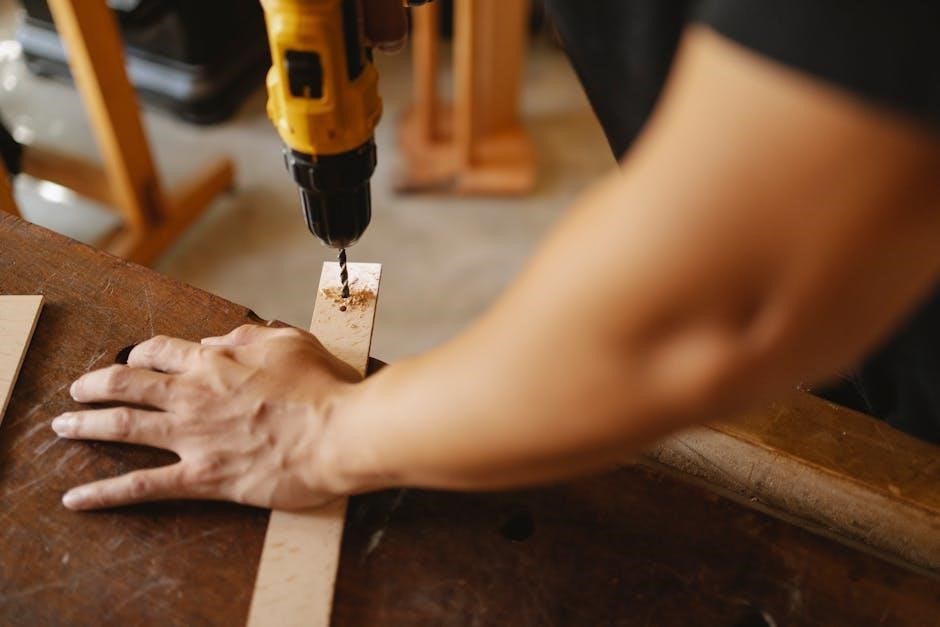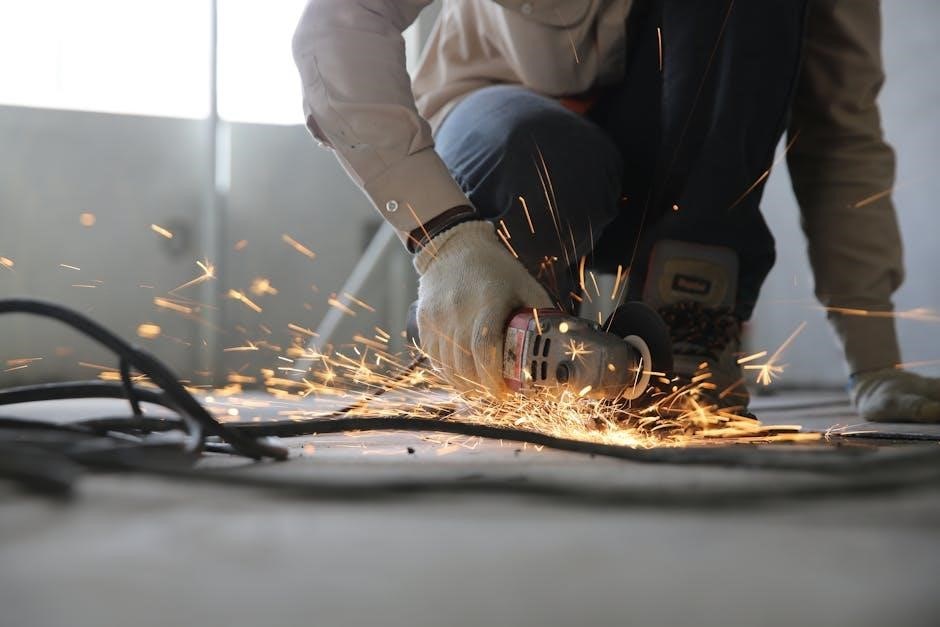Safety Guidelines and Precautions
Always wear protective gear, including gloves, safety glasses, and rubber boots. Avoid direct water streams near eyes or sensitive areas. Keep children and pets away while operating. Ensure proper drainage to prevent slipping hazards.
1.1. Personal Protective Equipment (PPE)
Wear protective gloves to prevent cuts and abrasions. Use safety glasses or goggles to shield eyes from debris.Equip yourself with rubber boots for traction and electrical protection. Avoid loose clothing that could get caught in the machine. Ensure long sleeves and full-length pants are worn to minimize skin exposure. Keep hair tied back and avoid jewelry. Always wear hearing protection if operating near loud environments. Make sure all PPE fits properly and complies with safety standards before starting the pressure washer.
1.2. Understanding Safety Icons and Symbols
Familiarize yourself with safety icons and symbols in the manual. The warning triangle indicates potential hazards that could cause injury. The caution symbol highlights risks of damage or non-fatal injury. The do not symbol specifies prohibited actions, such as using the washer near open flames. The electrical hazard symbol alerts users to risks of electric shock. Always read the manual thoroughly to understand these visuals. Ignoring these symbols can lead to serious injury or equipment damage. Ensure you recognize and follow all visual warnings before operating the pressure washer.
1.3. General Safety Rules for Operating a Pressure Washer
Always wear protective gear, including safety glasses and gloves, to prevent injury. Keep children and pets at a safe distance. Ensure the work area is well-ventilated and clear of debris. Avoid spraying direct water streams near eyes or sensitive areas. Never aim the nozzle at people or pets. Use the washer on a stable, level surface to prevent tipping. Follow all manufacturer guidelines for pressure settings and nozzle usage. Proper drainage is essential to reduce slipping hazards. Failure to follow these rules can result in serious injury or equipment damage.

Product Assembly and Initial Setup
Begin by unboxing and verifying all components are included. Carefully inventory each part to ensure nothing is missing. Follow the manual to attach the high-pressure hose and setup the pressure wand. Ensure all connections are secure before proceeding. Proper assembly is crucial for safe and effective operation.
2.1. Unboxing and Inventory of Components
Carefully unbox the pressure washer and verify all components are included. Check for any damage during shipping. Ensure the package contains the main unit, high-pressure hose, pressure wand, nozzle tips, and owner’s manual. Refer to the manual for a detailed list of parts and diagrams. If any items are missing or damaged, contact Craftsman customer support immediately. Properly inventorying ensures smooth assembly and operation, preventing delays or safety risks. Always follow the manual’s guidelines for part identification and setup.
2.2. Attaching the High-Pressure Hose
Locate the quick connect outlet on the pressure washer and align the high-pressure hose coupling. Gently push and twist the hose into place until it clicks, ensuring a secure connection. Repeat the process to attach the other end of the hose to the pressure wand. Verify all connections are tight to prevent leaks. If necessary, use a wrench to tighten any loose fittings. Always refer to the manual for specific diagrams or instructions to ensure proper installation and safety.
2.3. Setting Up the Pressure Wand and Nozzle
Attach the pressure wand to the high-pressure hose by aligning the connector and twisting until it clicks securely. Next, select the appropriate nozzle for your task and thread it onto the wand. Ensure the connection is tight to prevent leaks. For general cleaning, use a wide fan tip, while a narrow tip is better for tough stains. Always check connections for tightness and refer to the manual for specific nozzle recommendations and diagrams.

Operating the Craftsman Power Washer
Plug in the unit, ensure the water supply is connected, and prime the pump if necessary. Start the engine or turn it on for electric models. Adjust the pressure setting based on the surface type, using lower settings for delicate areas. Use the correct nozzle for the job, angling the wand to avoid direct streams at people or windows. Monitor detergent use to avoid over-application and potential damage.
3.1. Priming the Pump and Initial Start-Up
Before first use, prime the pump by squeezing the trigger gun to remove air from the system. For electric models, plug in the unit and turn it on. For gas-powered models, ensure the choke is engaged and pull the start cord firmly. Allow the engine to run for a few seconds to circulate water through the system. Repeat priming if air bubbles appear in the hose. This ensures proper water flow and prevents damage to the pump. Always check for leaks after priming.
3.2. Adjusting Pressure Settings for Different Surfaces
Adjust the pressure setting based on the surface being cleaned. For delicate surfaces, such as siding or windows, use a lower PSI setting (1200–1500 PSI). For concrete or driveways, increase to medium-high pressure (2000–2500 PSI). Heavy-duty surfaces like bricks or heavy stains may require maximum pressure (up to 3000 PSI). Always start with the lowest setting and gradually increase as needed to avoid damage. Use the correct nozzle for the selected pressure to ensure effective cleaning and prevent surface wear.
3.3. Using the Correct Nozzle for the Job
Select the appropriate nozzle based on the cleaning task. A wide fan nozzle is ideal for general cleaning, while a narrow nozzle is better for tough stains or heavy-duty surfaces. Use a low-pressure nozzle with detergents for delicate surfaces. Avoid using zero-degree nozzles on fragile materials like wood or vinyl. Always test the pressure on a small area first. Refer to the nozzle chart in the manual for specific recommendations to ensure optimal cleaning results without damaging the surface.

Maintenance and Troubleshooting
Regularly inspect and maintain the pressure washer to ensure optimal performance. Check for worn or damaged parts and replace them promptly. Refer to the manual for troubleshooting common issues like low pressure or pump failure. Clean the filter and nozzle after each use to prevent clogs. Store the unit in a dry, protected area during off-season to prevent damage from freezing temperatures.
4.1. Routine Maintenance Tasks
Perform routine maintenance to ensure your Craftsman power washer operates efficiently. Clean the filter and nozzle after each use to prevent clogs. Inspect and replace worn or damaged hoses, and lubricate all connections. Check the oil level and top it off as needed. Regularly inspect the high-pressure hose for signs of wear or cracking. Store the unit in a dry, protected area during the off-season. Drain the fuel and run the engine to burn off remaining fuel, or add a fuel stabilizer if storing for extended periods. Always refer to the manual for specific maintenance schedules.
4.2. Common Issues and Solutions
Common issues with your Craftsman power washer may include low pressure output, the unit not starting, or the engine stalling. For low pressure, check for kinked or damaged hoses and ensure the nozzle is clean. If the unit doesn’t start, verify fuel levels and ensure the air filter is clean. For engine stalling, inspect the fuel line for blockages and ensure proper ventilation. Always refer to the manual for specific troubleshooting steps and solutions to maintain optimal performance and prevent further issues.
4.3. Winterization and Storage Tips
To prepare your Craftsman power washer for winter, drain all water from the pump and hoses to prevent freezing. Store the unit in a dry, protected area away from direct sunlight and moisture. Disconnect the high-pressure hose and store it separately. Apply rust-inhibiting oil to metal parts if storing for an extended period. Ensure the fuel tank is empty or stabilized to prevent degradation. Cover the unit to protect it from dust and pests. Always follow the manufacturer’s guidelines for winter storage to maintain the longevity of your power washer.

Warranty and Customer Support
Your Craftsman power washer is backed by a comprehensive warranty. For details, visit the Craftsman website or call their customer support team. Proper maintenance ensures warranty validity.
5.1. Understanding the Warranty Terms
Your Craftsman power washer is covered by a limited warranty that protects against defects in materials and workmanship. The warranty period varies by component, with most parts covered for a specified duration from the purchase date. Proper maintenance and operation in accordance with the manual are required to maintain warranty validity. Damage caused by misuse, neglect, or normal wear and tear is not covered. For full details, refer to the warranty section in your manual or visit the Craftsman website.
5.2. Registering Your Product
Register your Craftsman power washer online or by mail to activate your warranty and receive exclusive updates. Visit the Craftsman website and fill out the registration form with your product details, purchase date, and contact information. This process helps Craftsman maintain a record of your purchase and ensures you receive timely support. Registration is optional but recommended for streamlined customer service and to stay informed about product updates or recalls. Keep your proof of purchase handy for verification. This step enhances your ownership experience and ensures compliance with warranty terms.
5.3. Contacting Craftsman Customer Service
For assistance with your Craftsman power washer, contact customer service via phone at 1-888-331-4569 or visit the official Craftsman website for live chat and support resources. Have your product model number and purchase date ready for efficient service. Representatives are available Monday-Friday, 8am-5pm EST. You can also submit inquiries through the contact form on their website. Always keep your proof of purchase handy for warranty-related issues. Craftsman customer service is dedicated to resolving your concerns promptly and effectively.
Environmental and Safety Compliance
Ensure eco-friendly usage by minimizing water and detergent use. Dispose of chemicals and waste properly. Always comply with local regulations and safety standards to protect the environment and ensure safe operation.
6.1. Eco-Friendly Usage Tips
Optimize water and energy use by selecting the correct pressure setting for the task; Use biodegradable detergents to minimize environmental impact. Regularly maintain the washer to prevent leaks and waste. Utilize the low-pressure setting for lighter cleaning jobs to conserve resources. Avoid using the pressure washer near water sources or drains to protect aquatic ecosystems. Always follow local environmental guidelines for chemical disposal and water usage to ensure sustainable and responsible operation of your Craftsman power washer.
6.2. Proper Disposal of Chemicals and Waste
Always dispose of chemicals and cleaning agents according to the product’s label instructions and local regulations. Never pour hazardous waste into drains or waterways. Collect wastewater from cleaning and dispose of it properly to prevent environmental contamination. Take used or leftover chemicals to a hazardous waste collection facility. For the pressure washer itself, recycle or dispose of it responsibly at an authorized recycling center. Remove any hazardous components, such as batteries, before disposal to ensure environmental safety.
6.3. Compliance with Local Regulations
Ensure compliance with all local, state, and federal regulations when operating or storing your Craftsman power washer. Check for any restrictions on noise levels, water usage, or emissions. Obtain necessary permits for commercial or large-scale use. Adhere to guidelines for wastewater disposal and chemical usage to avoid environmental harm. Familiarize yourself with local ordinances regarding equipment operation in residential or public areas. Failure to comply may result in fines or legal action. Always follow regulations to ensure safe and responsible use of your pressure washer.

Storage and Transportation
Store the Craftsman power washer in a dry, cool place, away from direct sunlight. Disconnect hoses and drain water to prevent freezing. Use a protective cover during storage; For transportation, secure the unit firmly to avoid damage. Always follow the manual’s guidelines for safe handling and moving the equipment.
7.1. Proper Storage Conditions
Store the Craftsman power washer in a dry, cool, well-ventilated area, protected from direct sunlight and freezing temperatures. Ensure the storage space is level and stable to prevent tipping. Disconnect and drain all hoses to avoid water damage or freezing. Use a protective cover to shield the unit from dust and moisture. Keep the power washer away from flammable materials and chemicals. Always secure loose parts and ensure the storage area is clean to maintain the equipment’s condition.
7.2. Safe Transportation Practices
When transporting the Craftsman power washer, ensure it is securely fastened to prevent movement during transit. Use tie-down straps or ropes to stabilize the unit in a vehicle or trailer. Protect the washer from exposure to extreme weather by covering it with a durable tarp or placing it in a covered area. Always drain water and fuel before transport to avoid leaks or spills. Wear protective gloves when handling the unit, and ensure the area is clear of obstacles to prevent accidents. Follow all local transportation regulations and avoid rough handling to maintain the equipment’s condition.
7.3. Securing the Unit for Long-Term Storage
Before storing the Craftsman power washer long-term, ensure all water and fuel are completely drained to prevent corrosion or spoilage. Cover the unit with a high-quality protective cover to shield it from dust and moisture. Store it in an upright, stable position on a firm surface. Choose a dry, well-ventilated area away from direct sunlight and pests. Secure the unit with straps or braces to prevent tipping. Regularly inspect the storage area to ensure it remains safe and dry. Always consult the manual for specific storage recommendations.
